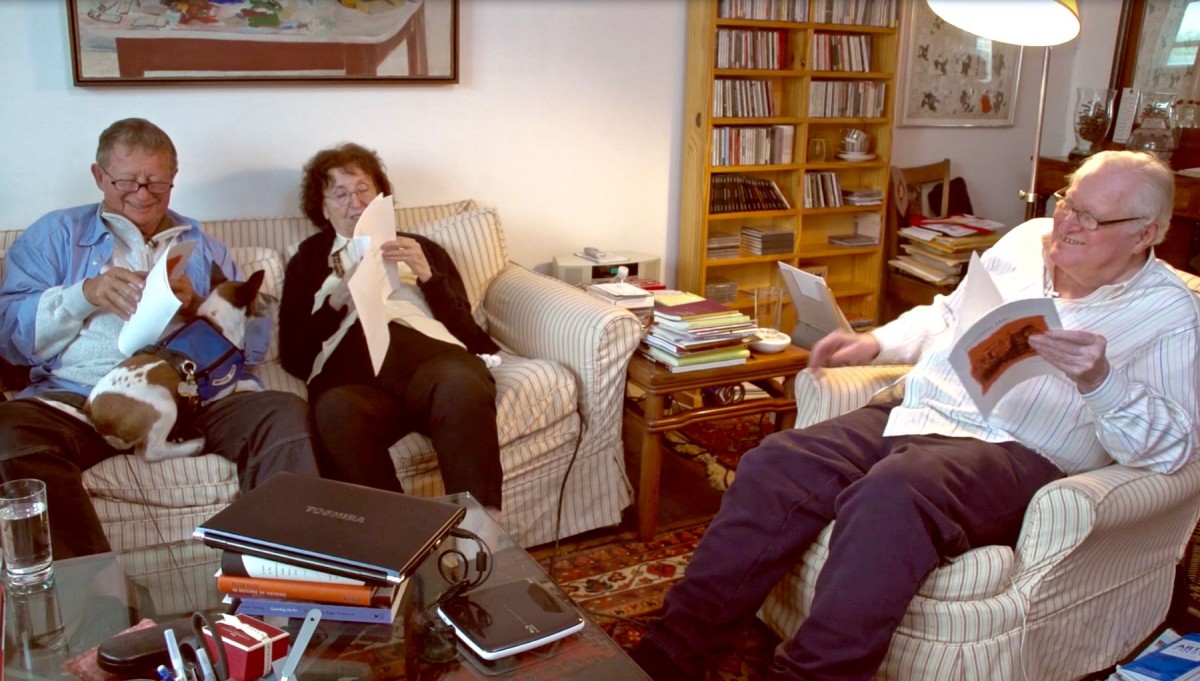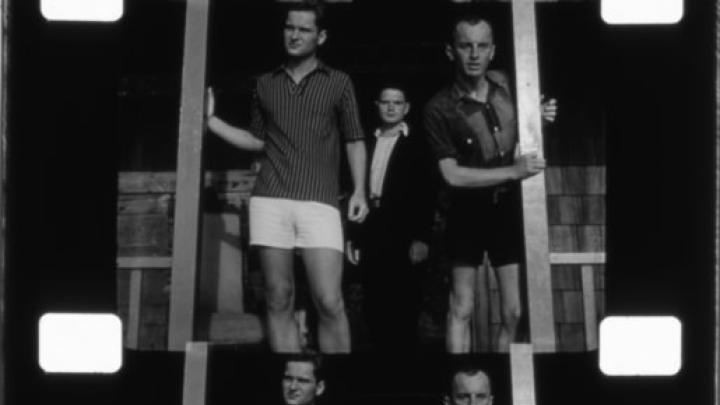During the summer of 1952, poets John Ashbery ’49, Litt.D. ’01, Frank O’Hara ’50, James Schuyler, and Kenneth Koch ’48, among other friends, all convened at a house in the Hamptons to enjoy a brief vacation and shoot a short movie, conceived and scripted by Schuyler. Over the years, their friendships would become formalized by critics and historians as the New York School—a sort of loose association of writers and artists all working and living together in mid-century New York. But that summer there was no “school,” just friends enjoying each other’s company, playing, being silly, making art, living.
The film, Presenting Jane, was to be yet another ode to the boys’ favorite muse, the painter Jane Freilicher, who ran in the same artistic circles but first met the bunch through Koch while living in the same apartment building. Freilicher was the first person Ashbery met when he moved to New York: his first stop in the city was at her apartment, to pick up Koch’s key. She would soon become subject of many a poem, most famously O’Hara’s “Jane” series. This time, through rudimentary cinematic trickery, she was to be made to look as though she could walk on water.
Never fully finished, Presenting Jane amounted only to a brief vignette. Nevertheless, the group premiered it in Greenwich Village the following year, its only public showing. Over time, the film would become a piece of lore among the poets who made it, talked about but largely unseen. For years it was presumed lost.
A few years ago, Karin Roffman, author of the forthcoming The Songs We Know Best: John Ashbery’s Early Life, did something simple that seemingly no one else had thought to do: call filmmaker Harrison Starr, who’d been hired to shoot the film. He poked around his house and found the reel, which had been sitting in his garage in the California heat for years, fermenting. When Roffman finally got her hands on it, it smelled like bananas and vinegar. In order to ensure its survival, she encouraged Starr to donate the reel to Harvard’s Woodberry Poetry Room (WPR) and the Harvard Film Archive, which jointly preserved it.
On October 17, in conjunction with the Woodberry Poetry Room, Roffman held a public screening of Presenting Jane for the first time at Harvard, where some major players of the New York School first forged their friendships. A small crowd of poetry devotees gathered in a room in the Barker Center, and I cozied myself onto a couch. The lights shut off, the film flicked on, and it was over almost as fast as it began: only 11 minutes in all, 7 of which were outtakes. Stripped of its original audio, and thus bereft of Schuyler’s script, the plot was essentially indiscernible. The biggest treat of the film itself, outside any biographical interest, was the beautiful shot of young Jane, ethereally draped in white, walking on planks submerged by Starr just beneath the water’s surface.

Filmmaker Harrison Starr (at left), Jane Freilicher, and John Ashbery reading the (then recently rediscovered) original script of Presenting Jane—a screenshot from the oral history filmed by the Woodberry Poetry Room in May 2014 in Ashbery's apartment in New York.
Courtesy of the Woodberry Poetry Room
To compensate for the loss of audio, Roffman and WPR curator Christina Davis made a fascinating move that contextualizes Presenting Jane and gives it more vigor. They took the film to John Ashbery and Jane Freilicher and recorded their commentary as they watched it together, for use as an audio track. Hearing their wistful reminiscences seems not only appropriate, given the film’s inherent home-video feel, but maybe even more desirable than the original script. We’re brought into the living room with Freilicher and Ashbery, listening to the banter just as we would while watching any friend’s old personal video. And anyone watching Presenting Jane today is likely more interested in the stories of its actors than in the short’s possible plot.
Over the years, the notion of a New York School has been consistently under siege, both by critics and the artists themselves. The common case against the classification is that it isn’t formally rigorous. The poets—and, for that matter, all the other artists with whom they spent such well-documented time—exhibit a wide range of styles, despite how close their friendships might have been. Critics argue, for example, that O’Hara’s personal, yearning directness is a far cry from Ashbery’s postmodern experimentation, even if, as Roffman notes, the two came to be known as “the twins” while at Harvard. Ashbery himself has balked at the idea of a New York School.
Proponents of the New York School idea think that such classification need not suggest a formal similarity. They insist that the relationships in space and time that all these artists forged are important enough to beg a historical reading of their work. To them, the New York School denotes friendships, mutual inspiration, and shared writing and loves, which they argue should be important bedrock for studying its designated members’ works. In this line of thought, a document like Presenting Jane, which shows all these individuals in their youthful insouciance, is essential material.
Roffman, who seems to fall generally into this second camp, suggested that this idea is, in fact, explicitly approached in Ashbery’s poetry. During her presentation, she cited a few lines from his 1977 poem “Pyrography”:
“To be able to write the history of our time, starting with today,
It would be necessary to model all these unimportant details
So as to be able to include them; otherwise the narrative
Would have that flat, sandpapered look the sky gets
Out in the middle west toward the end of summer….”
Herein lies the true joy of Presenting Jane. Regardless of whether they think the New York School exists, it’s impossible for any fan of these artists not to find the film—particularly its joy in unimportant details—intensely charming. We see a snapshot of a group of artists, who would eventually become major figures in American letters, simply as a group of young friends. And this snapshot takes them as they are: it sees their humor, their ease, and their shared love of being and creating with each other. In my favorite scene, Jane, John, and Frank sit at a table in the garden, all apparently doing their best to mock artistic pretension. Jane wears a beret and bikini, holds a sketchbook, and stares at a bowl of pears. John, scoffing, flips through a paperback and tears out the pages one by one. Frank, looking like a noble grump, slaps away at his typewriter with two fingers with the same fluid full-arm motions of an orchestra conductor. On the soundtrack, we hear John and Jane poking fun at their former selves, teasing the 20-year-olds on screen for smoking too many cigarettes or being too fascinated with the automatic windows of their Buick. Even at 11 minutes, it’s hard not to see details of Presenting Jane as an important salve to that flat, sandpapered sky.









